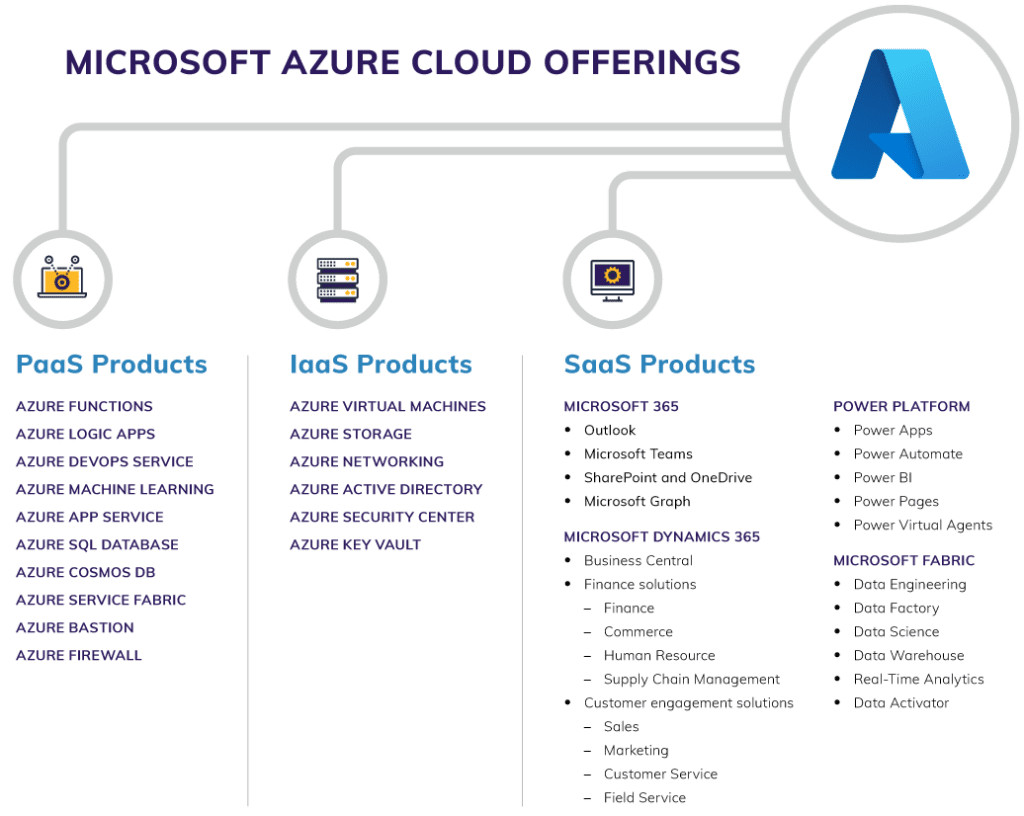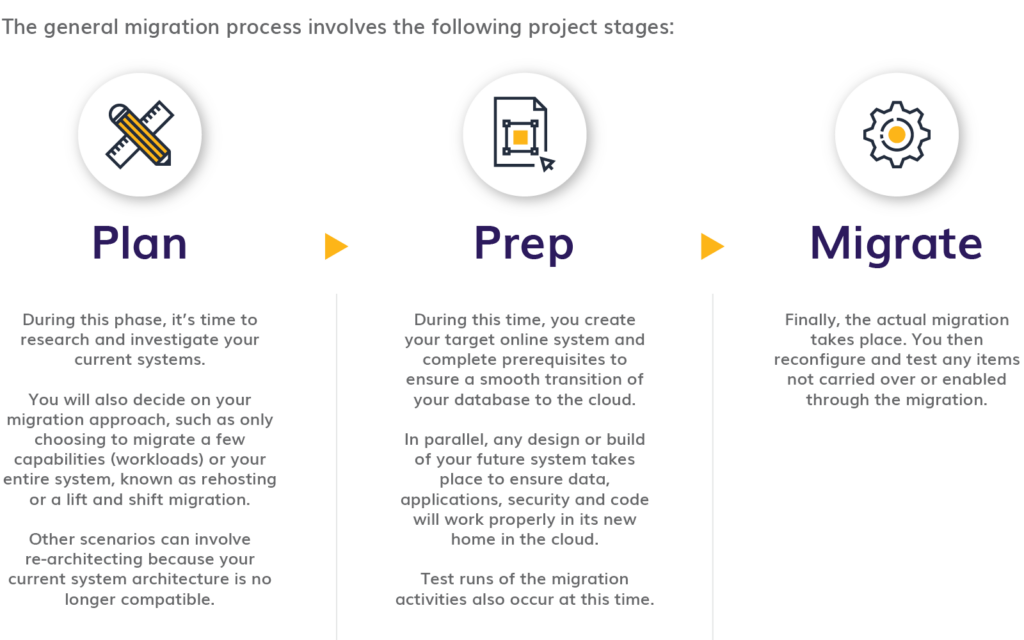A Microsoft Azure cloud migration might be the solution you need to take your business from on-prem to the security and flexibility of the cloud.
What the Microsoft Azure Cloud Migration Platform Offers
Why Internet Access to Computing Services Is Such a Big Deal
A Microsoft Cloud Migration Has Many Benefits
Migrate to the Cloud: A Process Overview
Cloud Migration and Computing Can Be Easy
Microsoft is a leader in several cloud service domains, especially regarding integration with other tools and security and compliance. It holds a 20 percent share of the worldwide cloud infrastructure market, second only to AWS. As a major player in the cloud migration boom, Microsoft has contributed a tremendous amount of innovation to cloud operations through its Azure cloud platform.
Let’s take a look at the platform in detail and discuss how an Azure cloud migration can benefit your business.
What the Microsoft Azure Cloud Migration Platform Offers
The Microsoft Azure Cloud services product offering comprises over 200 products across the three categories mentioned previously.
Microsoft Azure Cloud Offerings
Key Microsoft Azure PaaS product offerings include:
- Azure Functions – serverless computing to run event-driven code without having to manage infrastructure
- Azure Logic Apps – a service that automates workflows and integrates apps, data and services
- Azure DevOps Service – development tools to plan, develop and deliver software
- Azure Machine Learning – a cloud-based environment in which you can build, train, and deploy machine-learning models
- Azure App Service – a fully managed platform that lets you create web and mobile apps for any platform or device and connect to data anywhere on-premises or in the cloud
- Azure SQL Database – a fully managed relational database containing built-in intelligence and scalability
- Azure Cosmos DB – a global, multi-model database service to build very responsive applications
- Azure Service Fabric – a platform to build and manage microservices applications
- Azure Bastion – a fully managed provision service that furnishes secure RDP and SSH connectivity to all virtual machines within the virtual network for which it’s provisioned
- Azure Firewall – a cloud-native, intelligent network firewall security service that fully protects cloud workloads running in Azure
Key Microsoft Azure IaaS product offerings include:
- Azure Virtual Machines – a solution that lets you deploy and manage Windows and Linux operating systems in the cloud. You can customize the virtual machines to meet specific CPU, memory, and storage requirements and accommodate a broad range of applications.
- Azure Storage – a cloud storage platform offering highly available, scalable, durable, and secure storage for data objects in the cloud as well as secure, global access to that data over HTTP or HTTPS
- Azure Networking – networking services that connect and manage resources. These services can be used separately or together. They include load balancing and content delivery, hybrid connectivity to and from Azure resources such as VPN Gateway, ExpressRoute, and Virtual WAN, and virtual networking to create isolated networks in the cloud.
- Azure Active Directory – an all-encompassing identity and access management solution to manage user identities and access to resources
- Azure Security Center – a feature that establishes advanced threat protection and security management for all Azure resources. While it isn’t a part of the IaaS bundle, Microsoft Defender for Cloud keeps you in good standing with compliance requirements through a regulatory compliance dashboard that lets you manage and interact with compliance standards. You’re able to identify issues that are preventing you from meeting particular compliance certifications.
- Azure Key Vault – a service that securely stores and manages sensitive data such as certificates, passwords, and keys
Key Microsoft Azure SaaS product offerings include:
- Microsoft 365 – a cloud-based service that pairs Windows with a variety of apps and services, such as:
- Outlook – an app using Microsoft Exchange Outline as a messaging platform for delivering e-mail, calendar, tasks, and contacts
- Microsoft Teams – a service that creates one place for all employees in an enterprise to meet, chat, make calls, and collaborate
- SharePoint and OneDrive – services that empower organizations to share and manage content, knowledge and applications
- Microsoft Graph – the Microsoft 365 gateway to data and intelligence whose unified programmability model permits access to data in Microsoft 365, Windows, and Enterprise Mobility + Security
- Microsoft Dynamics 365 – a suite of cloud-based business applications to improve customer service, boost sales, and streamline operations, the key ones being:
- Business Central – an ERP solution to help small- and medium-sized businesses manage finance, sales, manufacturing, shipping, and project management functions.
- Daily business operations and finance solutions such as:
- Finance – for managing, accounting, budgeting, reporting and forecasting
- Commerce – for unifying back-office, in-store, call center, and digital activities
- Human Resource – for managing employee lifecycle phases, including recruiting, onboarding, performance management, and compensation
- Supply Chain Management – for end-to-end management of functions such as planning, sourcing, manufacturing, and delivery
- Customer engagement solutions such as:
- Sales – a CRM app to manage the entire sales process, from lead generation to customer support
- Marketing – for creating, tracking, and managing marketing campaigns
- Customer Service – for improving self-service, chat, e-mail, and phone support experiences
- Field Service – for helping mobile workers conduct on-site fixes with customers by combining workflow automation, scheduling algorithms, and mobility
- Power Platform – an intuitive low-code or no-code set of services that make it easier and quicker to build solutions, such as:
- Power Apps – for rapidly building custom apps for business needs
- Power Automate – for creating automated workflows between applications and services, covering processes that include communications, data collections, and decision approvals
- Power BI – business analytics that deliver data-analysis insights through data visualizations that create reports and dashboards to enable fast, informed decisions
- Power Pages – a secure, enterprise-grade, low-code platform for creating, hosting, and administering external-facing websites
- Power Virtual Agents – a guided, no-code graphical interface that lets subject matter experts create powerful, customized chatbots
- Microsoft Fabric – a unified solution that stores all tenant data in a single open format in OneLake, which includes:
- Data Engineering – to create lakehouse and operational workflows to build, transform, and share data estate.
- Data Factory – to empower organizations to extract value from data at unprecedented speed.
- Data Science – a machine-learning capability to identify trends and outliers and forecast values from data.
- Data Warehouse – to provide enterprise-wide strategic insights from multiple sources.
- Real-Time Analytics – to discover insights, monitor progress, and accelerate decision-making.
- Data Activator – to provide real-time data detection and monitoring and trigger notifications and actions when it finds specified patterns in data
Optimized Cloud Computing Costs
Beyond the staggering number of business applications and their vast collective functionality, Microsoft Azure offers multiple ways to optimize your cloud computing cost.
- Azure Advisor machine-learning algorithms identify unused and underused virtual machines and virtual machine scale sets and save money by recommending ideal ways to manage the size and number of these resources.
- Azure savings plans allow you to commit to a fixed hourly spend on computing services for a set period and can save up to 65 percent on pay-as-you-go prices.
- Predicted workloads over a set time can yield up to a 72 percent pay-as-you-go discount.
- Azure Hybrid Benefit helps organizations reduce expenses associated with cloud migration by offering discounts on Windows and SQL Server licenses and Linux subscriptions.
- Autoscaling — i.e., dynamically distributing resources to align with performance requirements — allows businesses to lessen management overhead and limit costs by de-allocating unneeded resources as work demand abates.
Integrated AI into Your Microsoft Cloud Migration
Microsoft cloud users can also fully take advantage of the most advanced AI and ML capabilities. For starters, note the above reference to Azure Advisor.
- Azure Machine Learning trains, deploys and manages machine learning models at scale. Its features include automated machine learning, prompt flow, model catalog, and ML flow integration.
- Azure Databricks is an analytics platform for building and deploying models and data workflows through integrations with open-source machine learning libraries and the ML flow platform.
- Azure AI Services are prebuilt AI capabilities that let you build intelligent applications using standard programming languages to call APIs that provide inferencing.
Improved Sustainability
Don’t forget the sustainability benefits of a Microsoft cloud migration, including cutting your carbon footprint by up to 98 percent. Microsoft’s emissions impact dashboard can estimate your carbon emissions, as well as the emissions already saved, and enlighten decision-making to create additional cloud-efficiency usages. The Azure Well-Architected Framework sustainability workload guidance can further optimize workloads and shrink the environmental impact.
Protection Against Disaster
You also want to make sure no incident or accident can permanently damage or lose any of your Microsoft cloud computing assets. Microsoft’s Azure Business Continuity Center is a cloud-native, unified business continuity and disaster recovery (BCDR) platform through which you can manage ironclad protection across the entire cloud computing landscape.
It provides single-pane-of-glass coverage to manage backup and replication that spans multiple workloads, vaults, subscriptions, and regions. You can identify and fix gaps in your protection estate and understand your protection settings for multiple protection policies.
The extent to which Microsoft Azure enables you to take advantage of the cloud makes so much sense because of how much computing power the cloud unlocks through the internet.
Why Internet Access to Computing Services Is Such a Big Deal
Technological evolution and new software capabilities give our businesses countless available tools and technologies to use. Of course, these new solutions are rooted in complex software that requires large amounts of storage, data processing, and computing power – an overwhelming prospect for a single computer.
Using an on-premises server network might help, but if your next product is so successful that it suddenly introduces more data, tools and users, that can put you on a non-stop treadmill to keep up with and deploy new infrastructure and programs to support your company.
Since the cloud lets you extend your machine’s computing power via the internet, it gives you the flexibility to choose how much computing power you want to use – with no major effort. With only a few clicks, you can easily expand and adopt new tools and technologies to keep up with your competition. Also, on the plus side, the business model for cloud products means you only buy what you need by licensing and purchasing capacity versus a one-size-fits-all software package.
Its economies of scale and computing power demonstrate why the cloud is such a compelling concept.
We know the work involved in migrating to the cloud is daunting, but Microsoft makes it easy for you.
A Microsoft Cloud Migration Has Many Benefits
Microsoft has up-to-date tools to facilitate your migration to the cloud. Azure Database Migration Service will simplify, guide and automate your database migration to the cloud, allowing you to move data, schema, and objects from multiple sources to the cloud at scale readily.
Azure Migrate simplifies migration and modernization with a unified platform. With this, you can easily identify and collect details about your infrastructure, databases, and applications; plot dependencies; and cost-out scenarios to make the business case for migration.
You can plan the move in phases when your on-premises resources are ready. Microsoft Cost Management gives you an accurate, efficient way to monitor, allocate, and optimize your cloud costs, empowering you to track use, expenses and cost discrepancies and predict expenditures.
Here are a few reasons why an Azure cloud migration — and taking advantage of their services — may be the right move for you.
Scenarios and Use Cases
1. Enhanced Security
Every day, Microsoft detects 1.5 billion attempts to undermine its cloud computing operations. Accordingly, Microsoft invests about $1 billion dollars in cloud security each year. That investment includes physical data centers, network connectivity, disaster recovery, and more than 100 offerings for compliance coverage – the most comprehensive of any cloud provider.
2. Access to Updates
Part of being in the cloud is enjoying the product updates and upgrades, where you’ll always have access to the latest enhancements, fixes, and features. Microsoft is constantly innovating its products, and it shares release plans once a year and rolls out patch updates to improve its security applications the second Tuesday of every month.
3. Access to the Microsoft FastTrack Program
The cloud allows your team to focus more on the systems and technology that are critical for your business instead of hardware maintenance.
For the quickest way to start taking advantage of the cloud, a “lift and shift” migration may be the best option. This requires taking all your existing systems as they are and moving them to the cloud, using the IaaS service offering.
The Microsoft FastTrack program – which is specific to Dynamics 365 migrations – makes this process a breeze. This program is run by a Microsoft product engineering team and offers best practices, tools, resources, and support while moving to the cloud. Indeed, the Microsoft Azure lift and shift cloud migration offering makes it easy to run applications in the cloud with only minimal changes to their existing configurations.
It’s only available to eligible customers. To find out if you’re eligible, click here.
4. Flexible Storage
The cloud allows for flexibility – you can choose how much storage and power you need and which applications make the most sense for you. With Microsoft’s pay-as-you-go cloud migration plan, you can start or stop services whenever you want and pay only for what you use. (Most Azure services are billed by the second, so your cost is for exactly what you consume.) Plus, you have the scalability to easily adjust resource usage to fit peak- or low-demand scenarios.
5. Prebuilt Customizations
Azure Software as a Service (SaaS) allows you to focus on what you do best instead of reinventing the wheel to create custom software that is difficult to maintain and won’t fit your future architecture. You can exploit pre-built software, and by accessing the existing functionality of Azure solutions, you save development time and resources and avoid making big changes to the fundamental code to address specific needs.
6. Software as a Service
Microsoft offers cloud services as a subscription, allowing you to pay a monthly fee to pick and choose which products and services to use. This is in contrast to on-premises, which requires a hefty investment in hardware and software as well as time to implement.
7. Access From Anywhere
Being bound to a network makes accessing information to do your job challenging. The cloud allows you to access your tools and systems from anywhere, at any time, on various devices, through the internet.
Something to keep in mind: While new features are certainly exciting, Microsoft’s focus on building their cloud product offerings often means newly released features are typically exclusive to online versions. These features also aren’t often made available to their on-premises counterparts. Eventually, they no longer support or deprecate any legacy features, which can result in outdated, highly issue-prone on-premises systems.
It’s helpful to have a step-by-step migration stage template to follow and an experienced, knowledgeable partner to guide you through the transition.
Your Azure Cloud Migration: A Process Overview
The general migration process involves the following project stages:
Plan, Prep, Migrate
Teaming up with a third-party partner can be very helpful when deciding on the best approach, prepping your future system, and getting things back up and running in your new system after the migration. This partner can not only help guide you through the process but also walk you through what you need to complete post-migration:
- Reconfigure any customizations such as JavaScript, custom code, and workflows.
- Update your integrations to connect with your new online instance.
- Update existing reports to ensure the online version supports the database query method. Often, this requires using Fetch XML versus any SQL queries.
The Azure Sponsorship for ISVs program helps independent software vendors ISVs use Azure services to foster platform innovations and create new solutions that can expedite your digital transformation.
As with all digital business applications, cloud applications require regular updates to maintain optimal operational excellence. That’s a given with Microsoft D365 CE Online.
Cloud Migration and Computing Can Be Easy
The business case for moving to the cloud is clear in that it provides you with the kind of computational versatility and power that is impossible to achieve through an on-premises server. Moreover, the cloud enables you to realize the internet’s full potential for data flow, storage, integration, connectivity, and analysis.
A Microsoft Azure cloud migration means you’ll spend much less time and energy operating and managing your tools so your team can focus on more productive tasks. Microsoft’s migration processes and business cloud offerings make the move easy and the subsequent cloud experience a joy.
Ready to harness the power of the cloud but not sure where to begin? Our Microsoft Azure Cloud experts are here to guide you through every step. Let’s talk











